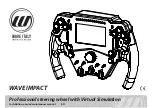
74
•
Chapter 6 Programming Motion
DMC-1500
Figure 6.6 - Trapezoidal velocity and smooth velocity profiles
Using the KS Command (Step Motor Smoothing):
When operating with step motors, motion smoothing can be accomplished with the command, KS.
The KS command smoothes the frequency of step motor pulses. Similar to the commands, IT and VT,
this produces a smooth velocity profile.
The step motor smoothing is specified by the following command:
KS x,y,z,w
where x,y,z,w is an integer from 1 to 16 and represents the amount of smoothing
The command, IT, is used for smoothing independent moves of the type JG, PR, PA and the
command, VT, is used to smooth vector moves of the type VM and LM.
The smoothing parameters, x,y,z,w and n are numbers between 0 and 16 and determine the degree of
filtering. The minimum value of 1 implies no filtering, resulting in trapezoidal velocity profiles.
Larger values of the smoothing parameters imply heavier filtering and smoother moves.
Note that KS is valid only for step motors.
Homing
The Find Edge (FE) and Home (HM) instructions may be used to home the motor to a mechanical
reference. This reference is connected to the Home input line. The HM command initializes the motor
to the encoder index pulse in addition to the Home input. The configure command (CN) is used to
define the polarity of the home input.
The Find Edge (FE) instruction is useful for initializing the motor to a home switch. The home switch
is connected to the Homing Input. When the Find Edge command and Begin is used, the motor will
accelerate up to the slew speed and slew until a transition is detected on the Homing line. The motor
will then decelerate to a stop. A high deceleration value must be input before the find edge command
is issued for the motor to decelerate rapidly after sensing the home switch. The velocity profile
generated is shown in Fig. 6.7.
The Home (HM) command can be used to position the motor on the index pulse after the home switch
is detected. This allows for finer positioning on initialization. The command sequence HM and BG
causes the following sequence of events to occur.
Upon begin, motor accelerates to the slew speed. The direction of its motion is determined
by the state of the homing input. A zero (GND) will cause the motor to start in the
forward direction; +5V will cause it to start in the reverse direction. The CN command is
used to define the polarity of the home input.
Upon detecting the home switch changing state, the motor begins decelerating to a stop.
The motor then traverses very slowly back until the home switch toggles again.
The motor then traverses forward until the encoder index pulse is detected.
The DMC-1500 defines the home position (0) as the position at which the index was detected.
Содержание DMC-1510
Страница 6: ......
Страница 18: ...6 Chapter 1 Overview DMC 1500 THIS PAGE LEFT BLANK INTENTIONALLY...
Страница 88: ...76 Chapter 6 Programming Motion DMC 1500 Figure 6 7 Motion intervals in the Home sequence...
Страница 90: ...78 Chapter 6 Programming Motion DMC 1500 THIS PAGE LEFT BLANK INTENTIONALLY...
Страница 137: ...DMC 1500 Chapter 7 Application Programming 125 THIS PAGE LEFT BLANK INTENTIONALLY...
Страница 157: ...DMC 1500 Chapter 10 Theory of Operation 145 THIS PAGE LEFT BLANK INTENTIONALLY...
Страница 160: ...148 Appendices DMC 1500 Card Level Layout...
Страница 178: ...166 Appendices DMC 1500 ICM 1100 Drawing 1 3 4 0 0 4 4 0 2 4 0 7 0 0 4 5 3 7 0 5 7 0 2 8 5 1 0 0 1 0 1 0 7 0 1 0 0...
Страница 180: ...168 Appendices DMC 1500...
Страница 198: ...186 Appendices DMC 1500 THIS PAGE LEFT BLANK INTENTIONALLY...
















































